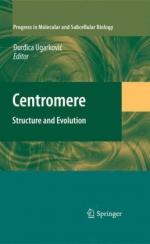|
This section contains 649 words (approx. 3 pages at 300 words per page) |

|
During mitosis in a typical plant or animal cell, each chromosome divides longitudinally into two sister chromosomes that eventually separate and travel to opposite poles of the mitotic spindle. At the beginning of mitosis, when the sister chromosomes have split but are still paired, every chromosome attaches to the spindle at a specific point along its length. That point is referred to as the centromere or spindle attachment region.
Images from an electron microscope show that each sister is attached to fibers emanating from only one pole of the spindle. This allows the sisters to be pulled to opposite poles during mitosis. The electron microscope images also show that the spindle fibers do not terminate on the chromosomes themselves but rather on separate structures, known as kinetochores. Kinetochores are trilaminar bodies that assemble at the centromeres during the early stages of mitosis and disappear after the chromosomes have...
|
This section contains 649 words (approx. 3 pages at 300 words per page) |

|


